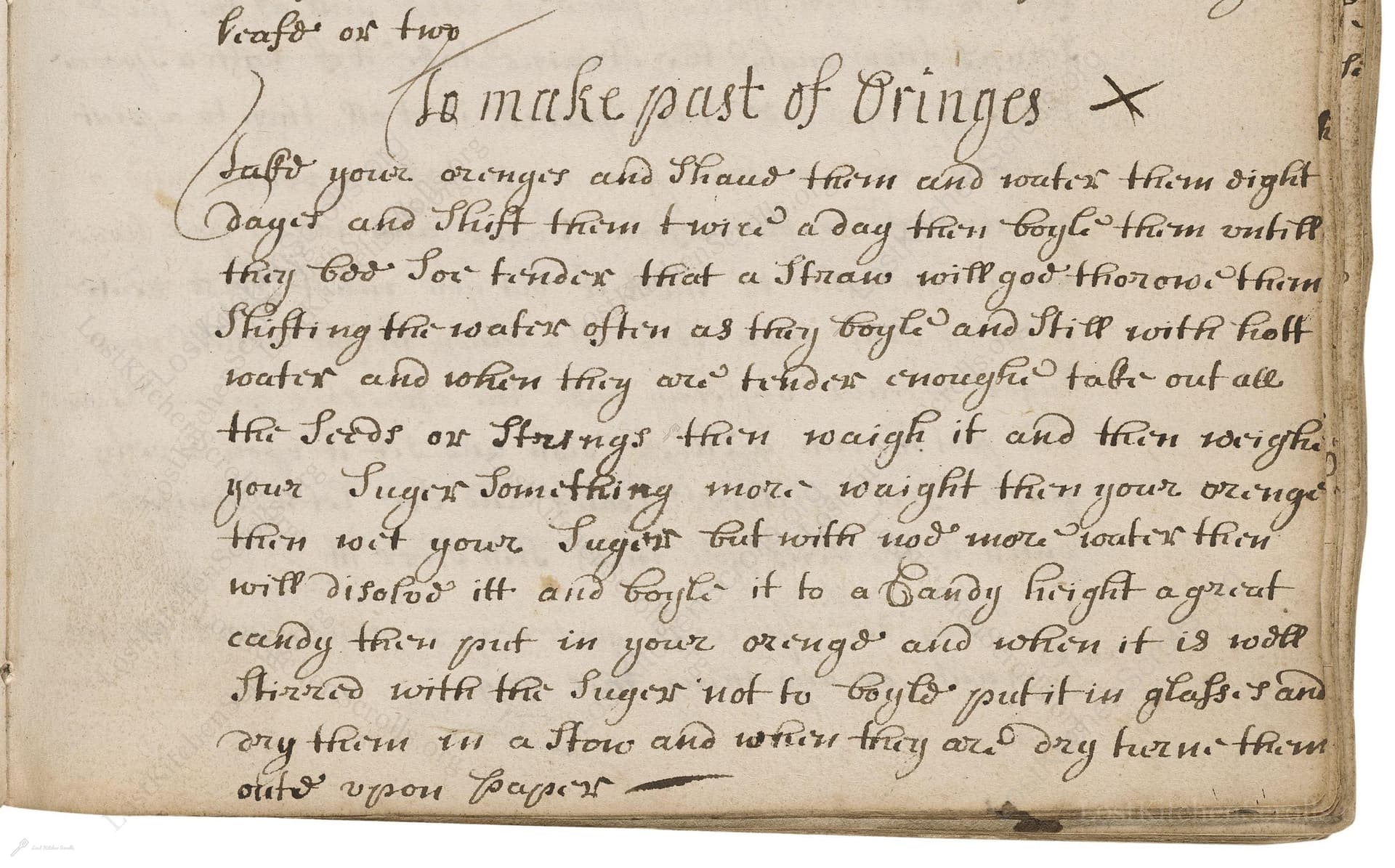To Make Past Of Oringes
From the treasured pages of Cookery book of Ann Goodenough
Written by Ann Goodenough

To Make Past Of Oringes
"take your oringes and blanch them and water them eight / Dayes and Shift them twice a day then boyle them untill / they bee Soe tender that a Straw will goe thorough them / Shifting the water often as they boyle and Still with fresh / water and when they are tender enoughe take out all / the seeds or Strings then waigh it and then waighe / your Suger Something more waight then your oringes / then beat your Suger but with noe more water then / will disolve itt and boyle it to a Candy height a great / candy then put in your oringe and when it is well / Stirred with the Suger not to boyle put it in glasse and / dry them in a Stow and when they are dry turn them / oute upon paper"
Note on the Original Text
Early modern recipes were written as brief instructions, assuming cooks already understood the basics of boiling sirup 'to candy height' or blanching fruit. Spelling reflects oral dialects and is inconsistent—'oringes' for oranges, 'bee' for be, 'boyle' for boil. Line breaks and slashes (/) act as punctuation and formatting, helping the eye through dense paragraphs in handwritten manuscripts. Quantities are proportional rather than exact, as scales could vary, and cooks were expected to adapt to what they had.

Title
Cookery book of Ann Goodenough (1738)
You can also click the book image above to peruse the original tome
Writer
Ann Goodenough
Era
1738
Publisher
Unknown
Background
A delightful journey into the kitchens of early 18th-century England, this collection captures the flair and flavors of its time with recipes crafted by the inventive Ann Goodenough. Expect a charming medley of hearty roasts, comforting pies, and time-honored confections, perfect for those wishing to dine as they did in Georgian days.
Kindly made available by
Folger Shakespeare Library
This recipe comes from the kitchen of Ann Goodenough, whose working life spanned the early to mid-18th century. At this time, sugar had become somewhat more affordable, and preserving fruit in sugar was both a culinary art and a sign of status. 'Paste of oranges' was not only a treat for winter but also a way to display refined household skills and hospitality. Such recipes were often passed among women of the gentry and aspiring middle classes, capturing both their taste for luxury and a pressing need to preserve food before refrigeration.

Cooks of the era would have used large copper or earthenware pots for boiling and soaking the oranges. A slotted spoon or simple wooden implements were used to lift fruit. Spoons and shallow earthen dishes or glass 'salvers' held the orange paste for drying. Baking would occur in a low, wood-fired 'stow' (stove or oven), and muslin or paper lined the final product.
Prep Time
P8DT30M
Cook Time
2 hrs
Servings
20
We've done our best to adapt this historical recipe for modern kitchens, but some details may still need refinement. We warmly welcome feedback from fellow cooks and culinary historians — your insights support the entire community!
Ingredients
- 4–6 medium oranges (ideally Seville) (approx. 2.2 lbs)
- 2 lbs 10 oz granulated sugar
- Water (as needed for blanching and syrup)
- Parchment paper (for drying and storage)
Instructions
- To make this historical orange paste, start by taking whole oranges (preferably Seville for their traditional tartness).
- Blanch them in boiling water, then soak them in fresh water for 8 days, changing the water twice daily.
- This long soaking removes bitterness from the peel.
- Next, simmer the oranges in fresh water, changing the water several times as you go, until they become so soft that a straw will pass through them easily.
- Remove all seeds and any stringy bits inside.
- Weigh the cooked oranges, then measure out slightly more sugar by weight than oranges.
- In a saucepan, dissolve the sugar with only enough water to cover, then bring it to the 'great candy height'—the stage where a drop of syrup forms a hard ball in cold water (around 250–266°F).
- Stir in the prepared oranges, mix well but do not let it boil further.
- Pour the mixture into glass dishes (or a tray) to dry in a low oven or dehydrator.
- Once set, turn out onto parchment paper.
Estimated Calories
180 per serving
Cooking Estimates
Blanching, soaking, simmering, and candying the oranges take time. Most of the effort is waiting for soaking and drying—the cooking itself is much shorter. With sugar and oranges, this sweet treat is rich in calories. The recipe makes about 20 servings.
As noted above, we have made our best effort to translate and adapt this historical recipe for modern kitchens, taking into account ingredients nowadays, cooking techniques, measurements, and so on. However, historical recipes often contain assumptions that require interpretation.
We'd love for anyone to help improve these adaptations. Community contributions are highly welcome. If you have suggestions, corrections, or cooking tips based on your experience with this recipe, please share them below.
Join the Discussion
Rate This Recipe
Dietary Preference
Main Ingredients

Den Bockfisch In Einer Fleisch Suppen Zu Kochen
This recipe hails from a German manuscript cookbook compiled in 1696, a time whe...

Die Grieß Nudlen Zumachen
This recipe comes from a rather mysterious manuscript cookbook, penned anonymous...

Ein Boudain
This recipe comes from an anonymous German-language manuscript cookbook from 169...

Ein Gesaltzen Citroni
This recipe, dating from 1696, comes from an extensive anonymous German cookbook...
Browse our complete collection of time-honored recipes



